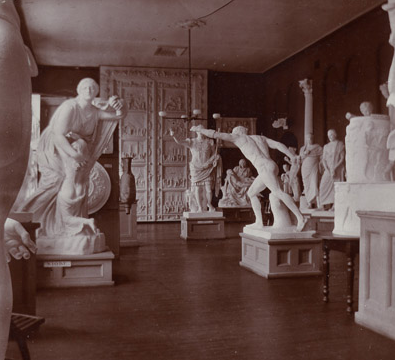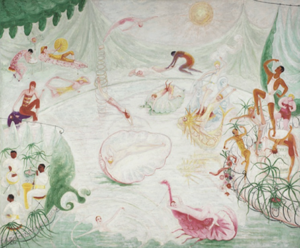In this weekly feature, we will share our ideas for what you can do “off-campus” while the museum is closed. Today’s post comes from Nicole M. Roylance, Coordinator of Public Education and Information.

In December 1914, Vassar College President Henry Noble McCracken drove through the main gates of campus to find a unusual assemblage. The College Art Department, including the Art Gallery, was moving into the newly built Taylor Hall. Lined up in the snow was the College’s plaster cast collection. The plaster casts had been purchased by Henry Van Ingen, the first professor of art at Vassar. Van Ingen, in keeping with nineteenth-century thought, had established this collection so that Vassar students could be taught the “correct idea of the high merit of ancient works.” Copies of the Apollo Belvedere, Nike of Samothrace, and Ghiberti’s Gates of Paradise were presented alongside original works of art to inspire and instruct students. At the turn of the twentieth century, faculty preferred teaching about antiquity through photographs of the originals instead of the plaster casts. On the snowy December day, President McCracken wrote that the casts were a “sad prophetic procession.” By the 1930s they had been relegated to Taylor basement. Today, only a few survive (you can find the Gates of Paradise installed in a stairwell in Taylor and a few other casts tucked in corners throughout the building).

Many museums in the United States that were founded in the nineteenth century have similar stories about casting off their cast collections. Objects that were once venerated were pushed aside to make way for original works of art. But where did all of these plaster casts go once institutions like Vassar or the Metropolitan Museum of Art no longer had use for them?
Enter James Perkins. Mr. Perkins purchased Aynhoe Park, a seventeenth-century estate in Oxfordshire, England. Aynhoe Park is the former home of the Cartwright family and portions were designed by the Georgian architect Sir John Soane. Mr. Perkins has made an effort to adhere to Sir John Soane’s guidelines for what an English country home should be and has been recognized by the Georgian Society for his efforts.

The home is filled with the what is regarded at the world’s finest collection of plaster casts. No longer suitable for museums, the casts take up residence in Mr. Perkins home and co-mingle with his taxidermy collection. The combination may be jarring to the twenty-first century visitor, but the original residents of Aynhoe Park would have been comfortable with this cabinet of curiosities. Aynhoe Park is open to the public (you can also rent the space for events) and you can also view pictures of this interesting estate online. I wonder if any of the casts were part of the snowy parade that President McCracken greeted on his way into work?





Just a smiling visitant here to share the love (:, btw great design.
Well I truly liked reading it. This tip offered by you is very effective for proper planning.
We absolutely love your blog and find the majority of your post’s to be just what I’m looking for. Would you offer guest writers to write content for yourself? I wouldn’t mind creating a post or elaborating on a few of the subjects you write related to here. Again, awesome weblog!